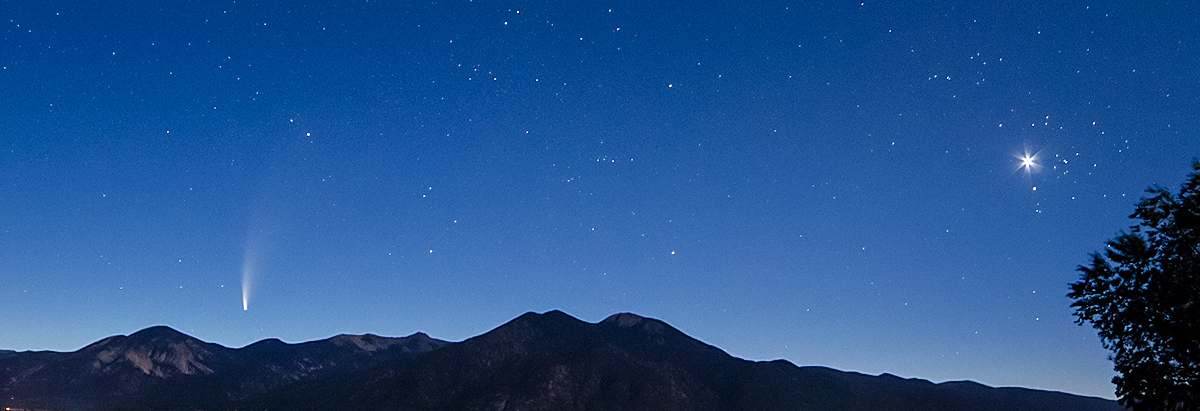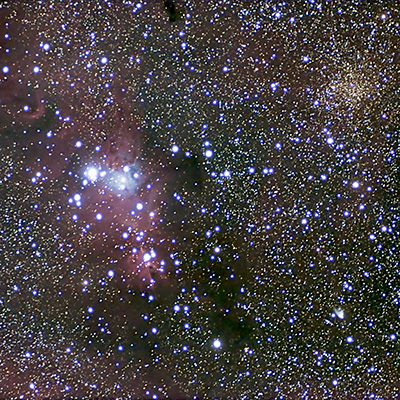
Welcome to taosastronomer.com!
offering
local "hands-on" observing
(visual and imaging) sessions and instruction
viewing and imaging from Rabbit Valley Observatory
a dark sky location on the mesa just west of Taos, NM
Rosette Nebular Complex and Cone Nebula and associated star clusters and deep sky objects -- informational page |
| From the fabulous (and free!) star chart website Cartes du Ciel emerges a general map of the Monoceros constellation area. This nondescript constellation lies to the east of well-known Orion, and contains several of the most interesting deep sky objects; among them are the spectacular star-forming region of the Rosette Nebular Complex as well as the smaller but equally interesting Cone Nebula region. Above is a general star map -- note Orion to the right (west) and Canis Minor and bright star Procyon (Alpha Canis Minor) left or east. In between is Monoceros and the objects as noted above -- very large (about the size of the gigantic Orion Nebula appearing on the bottom of this regional map) Rosette Nebular Complex (mapped as a blue blob, dead center) and the NGC2264 (New General Catalogue) designation for the star cluster associated with the Cone Nebula. More detailed maps and charts below. |
| From star chart website Cartes du Ciel now emerges a more detailed map of the deep-sky-object laden central Monoceros constellation area. The huge Rosette appears at the bottom of this chart, and is labeled NGC2239. Additional adjacent nebular areas are also noted. Above this and near the top of the map lies Christmas Tree open star cluster NGC2264, the Cone Nebula, Hubble's Variable Nebula and a beautiful, albeit faint open star cluster known as Tr5. More detailed charts, a Field of View (FOV) graphical estimate of my telescope and optical configuration, and my final resultant photograph of these objects appear below. |
| The above is a Field of View chart from AstroPlanner (I discuss the use of this excellent software on my visual observing page linked here) estimates just how much of the Rosette I can image with the indicated border lines, set to my camera's parameters. This sort of visual depiction allows the astrophotographer to determine whether or not the equipment matches up with the subject/object. I use this for most imaging now -- both for "fit" and for framing purposes. | This drawing, among other things, strongly suggests that the Rosette is a difficult object visually. Here are some details by the artist:
|
Here's my final effort for the Rosette -- the FOV indicator chart to the left is spun to match my framing. The Rosette Nebula is also known as Caldwell 49 (C49), the cluster within it is know as Caldwell 50 (C50) -- these Caldwell designations by Sir Patrick Alfred Caldwell-Moore, "Britain's tireless champion of astronomy." Throughout this website you will encounter such "Caldwell" designations. Here's a link to more information on how these objects were selected, including photographs and information about each. The Caldwell Catalogue is a list of deep sky objects similar to the (Charles) Messier list. The purpose of French comet-hunting astronomer Messier's historic list, however, unlike the Caldwell list, was to differentiate these objects from potential comets. Messier's selected objects are noted by the "M" designation preceding the number; i.e. M42, as an example. |
 |
| For the Cone Nebula and associated deep sky objects, we again turn to the visual depiction by star-mapping program Cartes du Ciel, as above. Note four distinct objects, NGC2264 (the Christmas Tree open star cluster), the Cone Nebula (below the cluster) NGC2261 (the enigmatic Hubble's Variable Nebula (C46), described below) and dim open star cluster Tr5. | Above is the FOV indicator and overlaid web-accessed observatory photos (also seen in the above chart of the Rosette) of sky chart software AstroPlanner. Note the same four objects. What is great about both of these charting software packages is that you can fine-tune both of them to really depict the exact Field-of-View you are working with. this property is especially important since you can't see most nebular objects in the telescope -- or at least you can't see them well enough to center them properly in the camera's frame. | Here is my final effort for the Cone Nebula region including the bluish Foxfur (reflection) Nebula, as opposed to the star-forming reddish emission nebula around the obscuring Cone Nebula. Also note the dark obscuring nebulae throughout this region. One additional note -- none of my maps originally had the yellow cluster Tr5 shown -- only after some deep digging (these charts use on-line reference star charts as plug-in's) did I even determine what cluster it was, even though it was clearly visible during the imaging session. Also, I would say that although I'm OK with this final result, this image does suffer a bit from drift -- this final image a result of 10 combined 8-minute plus exposures. That's a long time to keep everything perfectly aligned, even though the at-the-telescope guiding software somewhat automates this process. |
Please use this labeled astrophotograph above to help find your way around this very interesting and complex area. If you rollover the image, a less-confusing non-labeled one appears. When I was exposing the shot(s), I was amazed at what came up. I framed the shot in large measure because I was able to make out the (upside-down) Christmas Tree open star cluster, relatively easily seen in the test photographs. I frankly was surprised to see the Cone Nebula and associated emission nebulae emerging as I took longer and longer exposures -- finally deciding on 500-seconds per exposure (a very long time). I was also very pleased to see the color differential between the red emission and dark obscuring Cone and blue reflection Foxfur Nebulae, not usually so obvious and apparently only easily ascertained under dark skies. I obtained 10 images, and combined them digitally as described elsewhere within this website and linked here. Click on the smaller, non-labeled image above right or the proceeding text to access the less-bothersome-uncluttered-by-arrows-and-verbiage final Cone Nebula region astrophotograph. I also was quite surprised to see Hubble's Variable Nebula emerge so obviously from the darkness, and previous to the imaging session I had not even heard of the beautiful open star cluster designated Tr5 (Trumbler 5). I only accessed the more compete star charts including this plethora of deep sky objects after the astrophoto session. |
[copyright Rabbit Valley Observatory/Willis Greiner, 2016 -- all rights reserved] |
(all content copyright 2015-2019 Willis Greiner Photography, all rights reserved)